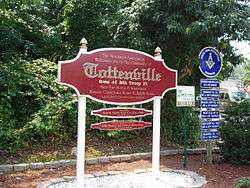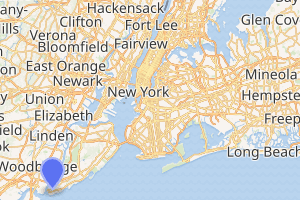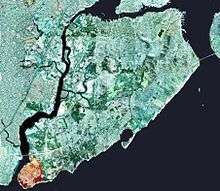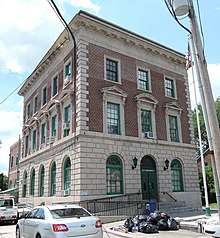Tottenville, Staten Island
Tottenville is a neighborhood on the South Shore of Staten Island, New York City. It is the southernmost settlement in both New York City and New York State. Tottenville is bounded on three sides by water: the south side abuts New York Bight while the west and north sides are bordered by Arthur Kill and the New Jersey state border. The eastern boundary is formed by Richmond Valley Road and Richard Avenue.
Tottenville | |
|---|---|
 Welcome To Tottenville sign | |

Location in New York City | |
| Coordinates: 40.506°N 74.243°W | |
| Country | |
| State | |
| City | |
| Borough | |
| Community District | Staten Island 3[1] |
| Area | |
| • Total | 6.49 km2 (2.505 sq mi) |
| Population (2011)[2] | |
| • Total | 14,945 |
| • Density | 2,300/km2 (6,000/sq mi) |
| Economics | |
| • Median income | $81,478 |
| Time zone | UTC−5 (Eastern) |
| ZIP Codes | 10307, 10309 |
| Area code | 718, 347, 929, and 917 |
Originally named Bentley Manor by one of its first settlers, Captain Christopher Billop (1638–1726), after a small ship he owned named the Bentley, the district was renamed Tottenville in 1869, apparently in honor of John Totten and the locally prominent Totten family, whose name can be seen on tombstones in one of the earliest churches, Bethel Methodist Church, on Amboy Road. Several Totten family members were Loyalists during the American Revolution and served under Captain Christopher Billopp.[3].
Tottenville is part of Staten Island Community District 3 and its ZIP Codes are 10307 and 10309.[1] Tottenville is patrolled by the 123rd Precinct of the New York City Police Department. Tottenville has been represented in the New York State Senate by Andrew Lanza since 2007.[4] It is represented in the New York State Assembly by Michael Reilly.[5]
History
Early history

The Raritan band of the Unami Indians, a branch of the Lenape or Delaware nation, were the original inhabitants of all Staten Island, including Tottenville. The largest pre-European burial ground known as Burial Ridge, is located in Conference House Park.
During the colonial period and for a significant time thereafter, Tottenville was an important waypoint for travelers between New York City—of which Staten Island did not formally become a part until 1898—and Philadelphia, as it was the site of a ferry that crossed the Arthur Kill to the Ferry Slip in Perth Amboy, New Jersey. The ferry became less important when the Outerbridge Crossing opened in 1928, but continued to operate until 1963.
Two distinctive landmarks stand at the northern approaches to the neighborhood: the Bethel United Methodist Church, erected in 1840 and rebuilt on the same site in 1886 after a fire destroyed the original structure; and an abandoned factory originally built in 1900 as Nassau Smelting's plant that was later used for recycling by Lucent Technologies (closed 2001). Tottenville is bounded on the west and south by the Arthur Kill, and on the east by Raritan Bay, the mouth of which lies immediately to the south of Arthur Kill's entry to the bay (which is also sometimes reckoned as being part of the Atlantic Ocean). The Conference House was built by Christopher Billop and so named because it was the site of unsuccessful negotiations to end the American Revolutionary War in 1776. The home is now the centerpiece of the city park of the same name. The Billop family, who built the estate in 1678, continued to own it and the surrounding property during the 1776 meeting, but their land was confiscated in 1784 because family members had been Tories during the war.
Tottenville has a strong Victorian architecture heritage, akin to neighborhoods on Staten Island's North Shore. This is unique to this South Shore neighborhood, compared to the other South Shore areas, all of which were developed much later. Seven buildings in Tottenville have been honored with the Preservation League of Staten Island Award: 88 Bentley Street, 24 Brighton Street, 213 Wood Avenue, 115 Bentley Street, 7647 Amboy Road, 7639 Amboy Road, and the Tottenville Branch of the New York Public Library. 88 Bentley Street has been photographed as an example of Staten Island's carefully restored Victorian homes in "New York City - The Five Boroughs: A Photographic Tour" by Carol M. Highsmith and Ted Landphair, published 1997. In addition, the Old Church of St. Joachim and St. Anne was restored after a fire into a home for children.
20th century
_(NYPL_b15279351-105073).tiff.jpg)
Many small factories once dotted the neighborhood's western shoreline, but most are no longer in operation. Boat construction also once flourished along the shoreline, but the industry was rendered obsolete in 1900 when boats began being constructed of steel rather than wood. World War I spawned a revival of shipbuilding activity, but it proved only temporary, and Tottenville's last shipyard closed in 1930. Another activity formerly prominent in Tottenville was the harvesting of oysters from the surrounding waters. This practice ceased in 1916 when the New York City Health Department determined that pollution made it unsafe. As of 2005, oyster harvesting has since been reopened.
Until the late 1950s, Tottenville 8 was one of the two telephone exchanges on the island with operators. The other was Honeywood 6. When dial service arrived, they were combined to become YUkon 4.
During the 1990s, the section of Tottenville southeast of Hylan Boulevard, until then nearly uninhabited, saw massive new home construction. The district's population density and crime rate still rank among the lowest in New York City. Until the 2000s, commercial development had largely been restricted to the Main Street corridor in the heart of the neighborhood. A second commercial core began to emerge at the north end of the community along Page Avenue and west of Amboy Road at this time. Further expansion on the neighborhood's north end was seen in 2005 with the redevelopment of the old Nassau Smelting plant. Site clean up began in October 2006, and was scheduled to be finished within a year. The site had suffered chemical contamination, as it was principally used to recycle copper and other metals from old wires. Mill Creek, which runs through the site, was also scheduled to be cleaned as part of the project.
Tottenville Beach was largely undeveloped until the 1990s. It is exclusively residential, and is bordered on the south and west by Conference House Park. While the beach that the area is named for is not popular with swimmers or sunbathers, it is a popular place for fishing. Several hotels dotted the shoreline in the area during the first half of the 20th century, including the Shore House Hotel. The Coral Bay Cafe restaurant operated there but was destroyed by Hurricane Sandy.
21st century
Many large, stately homes built in Tottenville in the 19th century remain standing. However, in recent years, land developers have been buying up the property on which several of these homes have stood, with the intention of demolishing them and constructing townhouses on the property. The fate of one such home, which had been the parsonage of Bethel Methodist Church, located at 7484 Amboy Road, (there was an extremely large back yard to this house) became the focus of an intense local controversy in March, 2005, when the community rose up in opposition to plans by builder John Grossi, who had purchased the property, to raze the home and construct five townhouse units on the site. On March 17 Grossi angrily spray-painted graffiti on the house, built circa 1870, which included a threat to populate it with low-income tenants under the federal Section 8 housing program; the resulting public outcry prompted New York City mayor Michael Bloomberg to have the home declared a landmark, thus preventing its demolition. Bloomberg announced his decision to do this during a visit to Tottenville on March 22, and the New York City Landmarks Preservation Commission made the designation official on April 12. After years of remaining uninhabited and in disrepair, the home was restored to its former glory in 2017.
In March 2008, over 20 blocks in the northern section of the neighborhood were changed over to one-way streets, more effectively managing traffic on the older, narrower blocks.
In 2016 30 acres of the Nassau Smelting property were purchased from Lucent Technologies by a consortium of Bridgewater Capital and the Brooklyn-based Riseman family. Plans to rezone the property from Manufacturing (M) to residential (RX3) in order to develop residential housing units were met with staunch criticism from the community due to concerns over contaminated soil from the heavy metals that were recycled during Lucent Technologies tenure of operation. The future use of this property remains undetermined.
Demographics
For census purposes, the New York City government classifies Tottenville as part of a larger neighborhood tabulation area called Charleston-Richmond Valley-Tottenville.[6] Based on data from the 2010 United States Census, the population of Charleston-Richmond Valley-Tottenville was 23,313, a change of 4,981 (21.4%) from the 18,332 counted in 2000. Covering an area of 3,432.93 acres (1,389.26 ha), the neighborhood had a population density of 6.8 inhabitants per acre (4,400/sq mi; 1,700/km2).[7] The racial makeup of the neighborhood was 84.4% (19,685) White, 2.6% (599) African American, 0.1% (13) Native American, 3.1% (720) Asian, 0% (5) Pacific Islander, 0.2% (39) from other races, and 0.9% (200) from two or more races. Hispanic or Latino of any race were 8.8% (2,052) of the population.[8]
The entirety of Community District 3, which comprises Tottenville and other South Shore neighborhoods, had 159,132 inhabitants as of NYC Health's 2018 Community Health Profile, with an average life expectancy of 81.3 years.[9]:2, 20 This is about the same as the median life expectancy of 81.2 for all New York City neighborhoods.[10]:53 (PDF p. 84)[11] Most inhabitants are youth and middle-aged adults: 21% are between the ages of between 0–17, 26% between 25–44, and 29% between 45–64. The ratio of college-aged and elderly residents was lower, at 8% and 16% respectively.[9]:2
As of 2017, the median household income in Community District 3 was $96,796,[12] though the median income in Tottenville individually was $81,478.[2] In 2018, an estimated 11% of Tottenville and the South Shore residents lived in poverty, compared to 17% in all of Staten Island and 20% in all of New York City. One in sixteen residents (6%) were unemployed, compared to 6% in Staten Island and 9% in New York City. Rent burden, or the percentage of residents who have difficulty paying their rent, is 42% in Tottenville and the South Shore, compared to the boroughwide and citywide rates of 49% and 51% respectively. Based on this calculation, as of 2018, Tottenville and the South Shore are considered high-income relative to the rest of the city and not gentrifying.[9]:7
The neighborhood is mostly made of upper-middle-class families, and has the highest proportion of Roman Catholics than any other neighborhood on the island (94% Roman Catholic). In the mid 2000s the community witnessed the arrival of Mexican immigrants for the first time. There is also a growing number of Coptic Orthodox Christians from Egypt; as of 2012, the Virgin St. Mary and St. George Coptic Orthodox Church in Tottenville[13] is one of two Coptic Parishes on Staten Island.[14] Tottenville's white Population is 60% Italian as of 2012.[15]
Politics
The neighborhood is represented in the New York City Council by Joe Borelli, in the New York State Senate by Andrew Lanza, and in the New York State Assembly by Michael Reilly.[16] Tottenville is located within Staten Island Community District 3.[1]
Climate
| Climate data for Perth Amboy, New Jersey (across river/kill from Tottenville) | |||||||||||||
|---|---|---|---|---|---|---|---|---|---|---|---|---|---|
| Month | Jan | Feb | Mar | Apr | May | Jun | Jul | Aug | Sep | Oct | Nov | Dec | Year |
| Average high °F (°C) | 39 (4) |
43 (6) |
52 (11) |
64 (18) |
74 (23) |
83 (28) |
87 (31) |
85 (29) |
78 (26) |
66 (19) |
55 (13) |
43 (6) |
64 (18) |
| Average low °F (°C) | 23 (−5) |
25 (−4) |
32 (0) |
41 (5) |
50 (10) |
60 (16) |
65 (18) |
64 (18) |
56 (13) |
45 (7) |
36 (2) |
28 (−2) |
44 (7) |
| Average precipitation inches (mm) | 3.63 (92) |
3.06 (78) |
4.13 (105) |
4.01 (102) |
4.22 (107) |
4.21 (107) |
5.50 (140) |
3.73 (95) |
4.57 (116) |
4.21 (107) |
3.85 (98) |
4.00 (102) |
49.12 (1,248) |
| Source: [17] | |||||||||||||
Entertainment
The Stadium Theatre, a 1,037-seat movie theater, was located in Tottenville from 1927 to 1957. In January 1969 it re-opened as the New Stadium Theatre and was a rock-music venue hosting bands such as The Brooklyn Bridge. By the 1970s it had become the site of a roller rink.[18]
Police and crime

Tottenville and the South Shore are patrolled by the 123rd Precinct of the NYPD, located at 116 Main Street.[19] The 123rd Precinct ranked safest out of 69 patrol areas for per-capita crime in 2010.[20] With a non-fatal assault rate of 25 per 100,000 people, Tottenville and the South Shore's rate of violent crimes per capita is less than that of the city as a whole. The incarceration rate of 193 per 100,000 people is lower than that of the city as a whole.[9]:8
The 123rd Precinct has a lower crime rate than in the 1990s, with crimes across all categories having decreased by 82.4% between 1990 and 2018. The precinct reported 0 murders, 2 rapes, 11 robberies, 44 felony assaults, 24 burglaries, 198 grand larcenies, and 31 grand larcenies auto in 2018.[21]
Fire safety
Tottenville is served by the New York City Fire Department (FDNY)'s Engine Co. 151/Ladder Co. 76, located at 7219 Amboy Road.[22][23]
Health
Preterm and teenage births are less common in Tottenville and the South Shore than in other places citywide. In Tottenville and the South Shore, there were 77 preterm births per 1,000 live births (compared to 87 per 1,000 citywide), and 3.6 teenage births per 1,000 live births (compared to 19.3 per 1,000 citywide).[9]:11 Tottenville and the South Shore have a low population of residents who are uninsured. In 2018, this population of uninsured residents was estimated to be 4%, less than the citywide rate of 12%, though this was based on a small sample size.[9]:14
The concentration of fine particulate matter, the deadliest type of air pollutant, in Tottenville and the South Shore is 0.0066 milligrams per cubic metre (6.6×10−9 oz/cu ft), less than the city average.[9]:9 Seventeen percent of Tottenville and the South Shore residents are smokers, which is more than the city average of 14% of residents being smokers.[9]:13 In Tottenville and the South Shore, 26% of residents are obese, 9% are diabetic, and 22% have high blood pressure—compared to the citywide averages of 24%, 11%, and 28% respectively.[9]:16 In addition, 17% of children are obese, compared to the citywide average of 20%.[9]:12
Ninety-five percent of residents eat some fruits and vegetables every day, which is more than the city's average of 87%. In 2018, 88% of residents described their health as "good," "very good," or "excellent," more than the city's average of 78%.[9]:13 For every supermarket in Tottenville and the South Shore, there are 4 bodegas.[9]:10
The nearest major hospital is Staten Island University Hospital South Campus in Prince's Bay.[24]
Post office and ZIP Codes
Tottenville is located mostly within the ZIP Code 10307, though the far eastern and northern edges are part of 10309.[25] The United States Postal Service operates one post office in Tottenville, located at 228 Main Street.[26]
Education
Tottenville and the South Shore generally have a similar rate of college-educated residents to the rest of the city. While 41% of residents age 25 and older have a college education or higher, 8% have less than a high school education and 51% are high school graduates or have some college education. By contrast, 39% of Staten Island residents and 43% of city residents have a college education or higher.[9]:6 The percentage of Tottenville and the South Shore students excelling in math rose from 48% in 2000 to 65% in 2011, though reading achievement declined from 55% to 52% during the same time period.[27]
Tottenville and the South Shore's rate of elementary school student absenteeism is lower than the rest of New York City. In Tottenville and the South Shore, 12% of elementary school students missed twenty or more days per school year, less than the citywide average of 20%.[10]:24 (PDF p. 55)[9]:6 Additionally, 89% of high school students in Tottenville and the South Shore graduate on time, more than the citywide average of 75%.[9]:6
Schools
Tottenville High School, a public school, was originally located in the neighborhood, but a new campus was opened approximately three miles to the north, in the neighborhood of Huguenot, in 1971 (Totten Intermediate School 34 or I.S. 34, an intermediate school, now occupies the original high school building). One of the area's oldest buildings is the old building of P.S.1 (the Tottenville School), dating from 1878, and is unique for its traditional sloped roof. Today it is still in operation, now served by a second, newer building as well, built in 1929. In 2000, a new elementary school, P.S.6 (the Corporal Allan F. Kivlehan School), was opened to serve eastern Tottenville's growing population, as well as other neighboring areas. Tottenville's local Catholic school was Our Lady Help of Christians School, which was run under Our Lady Help of Christians Parish. The school dates back to 1904. It was announced in February, 2019 that this school would close at the end of the 2018-2019 school year.[28]
Library
The New York Public Library (NYPL)'s Tottenville branch is located at 7430 Amboy Road. The one-story Carnegie library building was designed by Carrère and Hastings and opened in 1904. It is a New York City designated landmark.[29]
Transportation
The Tottenville station has been the southern terminus of the Staten Island Railway since the railway was extended to the neighborhood on June 2, 1860. Today, the neighborhood of Tottenville contains the two southernmost stations along the line: Tottenville station (the southernmost railway station in New York state), and Arthur Kill station.[30] Before Arthur Kill opened on January 21, 2017, there were two other stations which were Atlantic (named after the defunct Atlantic Terra Cotta Co. factory nearby) and Nassau (referring to Nassau Smelting and Refining, the original name of the factory later taken over by Lucent Technologies), which closed on the same day that Arthur Kill was opened, as Arthur Kill replaced both of them. Atlantic and Nassau stations are now closed and demolished. The 14-mile trip to the St. George Terminal takes 42 minutes.[31]
Tottenville is served by the S59 and S78 local buses. Express bus service to and from Manhattan is provided by the SIM2, SIM25 and SIM26.[32]
Though no highways pass through the neighborhood, NY Route 440 and Korean War Veterans Parkway (formerly known as Richmond Parkway) are located nearby.
Notable residents
- Patti Hansen, a model and actress who is married to Rolling Stones guitarist Keith Richards, was born and raised in Tottenville.
- George H. Pepper, turn of the 20th century archeologist whose notable work included digs from the local Burial Ridge to Chaco Canyon in New Mexico, was born here.
- Paul Zindel, 20th century playwright and young adult author, was born here.
- Andy Milligan, American playwright, screenwriter, actor and filmmaker, operated a hotel and lived here in the mid-1970s.[33]
References
- "NYC Planning | Community Profiles". communityprofiles.planning.nyc.gov. New York City Department of City Planning. Retrieved March 18, 2019.
- "Tottenville neighborhood in New York". Retrieved March 18, 2019.
- Morris, Ira K.Morris's Memorial History of Staten Island, New York, Volume 2, 1900,page 22
- https://www.nysenate.gov/senators/andrew-j-lanza
- https://nyassembly.gov/mem/Michael-Reilly/bio/
- New York City Neighborhood Tabulation Areas*, 2010, Population Division - New York City Department of City Planning, February 2012. Accessed June 16, 2016.
- Table PL-P5 NTA: Total Population and Persons Per Acre - New York City Neighborhood Tabulation Areas*, 2010, Population Division - New York City Department of City Planning, February 2012. Accessed June 16, 2016.
- Table PL-P3A NTA: Total Population by Mutually Exclusive Race and Hispanic Origin - New York City Neighborhood Tabulation Areas*, 2010, Population Division - New York City Department of City Planning, March 29, 2011. Accessed June 14, 2016.
- "Tottenville and Great Kills (Including Annadale, Eltingville, Great Kills, Huguenot, Oakwood, Rossville and Tottenville)" (PDF). nyc.gov. NYC Health. 2018. Retrieved March 2, 2019.
- "2016-2018 Community Health Assessment and Community Health Improvement Plan: Take Care New York 2020" (PDF). nyc.gov. New York City Department of Health and Mental Hygiene. 2016. Retrieved September 8, 2017.
- "New Yorkers are living longer, happier and healthier lives". New York Post. June 4, 2017. Retrieved March 1, 2019.
- "NYC-Staten Island Community District 3--Tottenville, Great Kills & Annadale PUMA, NY". Retrieved July 17, 2018.
- "H.H. Pope Shenouda III consecrates St. Mary & St George, Staten Island, New York". Hope Pictures.
- "Coptic churches in 10307". Coptic Orthodox Church Network. Retrieved 2012-03-18.
- "Selected Social Characteristics in the United States 2008-2012". American Community Survey U.S. Census. Archived from the original on 2020-02-12. Retrieved 2014-01-09.
- https://nyassembly.gov/mem/Michael-Reilly/
- "Average weather for Perth Amboy, New Jersey". Weather.com. Retrieved December 20, 2008.
- "Stadium Theatre in Staten Island". Cinema Treasures. Cinema Treasures, LLC. Retrieved January 26, 2019.
- "NYPD – 123rd Precinct". www.nyc.gov. New York City Police Department. Retrieved October 3, 2016.
- "Great Kills and Tottenville – DNAinfo.com Crime and Safety Report". www.dnainfo.com. Retrieved October 6, 2016.
- "123rd Precinct CompStat Report" (PDF). www.nyc.gov. New York City Police Department. Retrieved July 22, 2018.
- "Engine Company 151/Ladder Company 76". FDNYtrucks.com. Retrieved March 14, 2019.
- "FDNY Firehouse Listing – Location of Firehouses and companies". NYC Open Data; Socrata. New York City Fire Department. September 10, 2018. Retrieved March 14, 2019.
- "Best 30 Hospitals in Staten Island, NY with Reviews". Yellow Pages. December 1, 2009. Retrieved March 19, 2019.
- "Tottensville, New York City-Staten Island, New York Zip Code Boundary Map (NY)". United States Zip Code Boundary Map (USA). Retrieved March 19, 2019.
- "PO Locator | USPS". tools.usps.com. Retrieved 2020-02-02.
- "Tottenville / Great Kills – SI 03" (PDF). Furman Center for Real Estate and Urban Policy. 2011. Retrieved October 5, 2016.
- "Our Lady Help of Christians: School closure 'devastating'". silive. 2019-02-05. Retrieved 2020-02-02.
- "About the Tottenville Library". The New York Public Library. Retrieved March 14, 2019.
- "Subway Map" (PDF). Metropolitan Transportation Authority. October 21, 2019. Retrieved January 18, 2018.
- "New Arthur Kill Station". mta.info. Metropolitan Transportation Authority. January 20, 2017. Retrieved January 20, 2017.
- "Staten Island Bus Map" (PDF). Metropolitan Transportation Authority. August 2018. Retrieved August 18, 2018.
- McDonough, Jimmy. (2001). The ghastly one : the sex-gore netherworld of filmmaker Andy Milligan (1st ed.). Chicago, IL: A Cappella. ISBN 1556524269. OCLC 47177013.